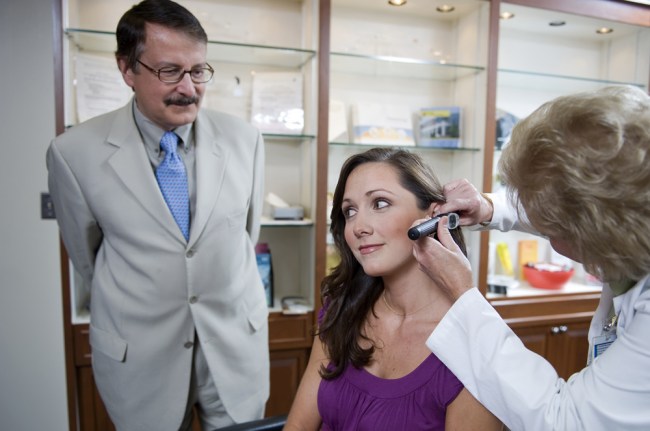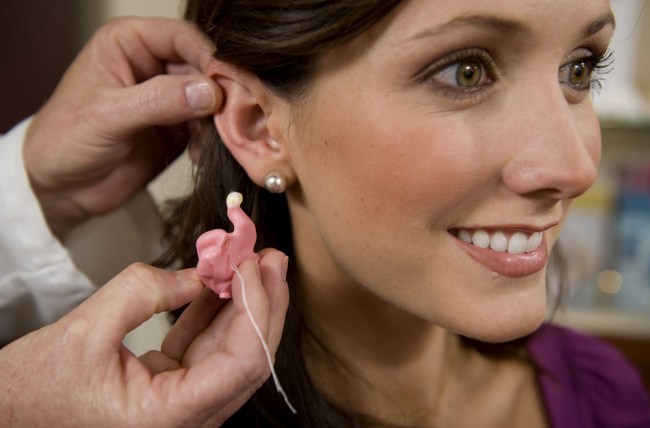
Ron Eavey, M.D., and audiologist Lisa Sykes work with patient Grace Gore in the Vanderbilt Bill Wilkerson Center. (photo by Joe Howell)
MTV survey cranks up the volume on loud music’s impact on hearing
Children and adults at risk of permanent hearing loss due to repeated exposure to loud music would turn down the sound or use ear protection if told to do so by a health care professional, a new Vanderbilt study performed in conjunction with MTV.com shows.
The study “Intentional Exposure to Loud Music: The 2nd MTV.com Survey Reveals an Opportunity to Educate,” from Vanderbilt’s Ron Eavey, M.D., is being released today in the Journal of Pediatrics.
Eavey conducted the research in 2007 while working at Massachusetts Eye and Ear Infirmary at Harvard; it is a follow-up to his groundbreaking 2002 MTV survey.
“Hearing loss is so prevalent that it has become the norm,” said Eavey, director of the Vanderbilt Bill Wilkerson Center and chair of the Department of Otolaryngology.
“We know where we are headed; it would be a miracle if we don’t wind up with problems later on. Studies show that 90 percent of males age 60 and over now have hearing loss.”
Nearly half of 2,500 MTV.com respondents experienced symptoms such as tinnitus or hearing loss after loud music exposure and hearing loss was considered a problem by 32 percent of respondents.
Eavey’s study found the media as the most informative source about prevention of potential hearing loss and the health care community as the least likely source, even though respondents said they would change behavior if a health care professional alerted them to the problem.
“Since our last study we have learned that enough people still are not yet aware, but that more are becoming aware, especially through the help of the media,” Eavey said.
“We have learned that the audience does use public health behaviors like sunscreen, designated drivers and seatbelts and that the health care community is the least likely source of informing patients about hearing loss, so we have an excellent opportunity to start educating patients.”
As a health care provider, Eavey suggests alerting patients that “hearing loss from excessive sound volume is preventable … and once it happens, the loss is permanent and cannot be reversed. Even hearing aids might not help that type of hearing loss and the ringing of the ears that can occur.”
Seventy-five percent of respondents owned an MP3 player, with 24 percent listening to their music player for more than 15 hours a week.
Nearly half of the respondents said they use their player at 75 percent to 100 percent of its maximum volume capacity, which exceeds government regulations for occupational sound levels.
If external sounds such as subway noise or street traffic compete with the music, then the volume is turned up even higher, according to 89 percent of persons surveyed.
“It is kind of like the bus is heading down towards the brick wall and you can see that the crash is going to come. Do you need to show that the bus crashed into the wall before you can report this? You either have to move the bus or push that wall way back. So that’s what we are trying to do,” Eavey said.
“We are starting off with a baseline of people from our last study who are now getting elderly, and who didn’t have MP3 players, who now have hearing loss.”
Audiophiles imprinted for safety
Miss Tennessee America 2007 Grace Gore is infatuated with ears, of all things.
Living in Nashville, Tenn., also known as “Music City,” and working at Vanderbilt as a doctoral student of Audiology, has given her some time to think about hearing protection and to listen to what people in her field are saying about the dangers of hearing loss.
On June 24 she did something about it while sitting in what appeared to be a barber’s chair, biting down on a small white Styrofoam block, and having impressions made of her ears with a silly putty-like substance.
“I was fitted for musician’s earplugs,” Gore said. “Living here in Nashville I love going to live music venues whenever I can and, so many times, I leave and my ears are just ringing from all of the noise.”

Former Miss Tennessee Grace Gore is fitted for musician's earplugs at the Vanderbilt Bill Wilkerson Center. (photo by Joe Howell)
Vanderbilt audiologist Lisa Sykes, Au.D., was doing for Gore what she does for Music Row’s best-of-the-best every day, protecting the ears so they can continue to enjoy doing what they love to do and keep making money to do it.
Sykes estimates she sees roughly 30 patients a month for music-related services, including musician’s earplugs, which cost around $150 a pair. This is only a drop in the bucket when considering how many local residents work in the music industry.
“We see a lot of students, professional musicians, audio engineers, even people like me who enjoy going out to live venues,” Sykes said. “Audiophiles are what they are called now … young music lovers. That’s all they do is listen to music.
“It is a matter of how long they are going to be around it, the duration, in addition to the intensity, how loud it is, which, over time, will cause your hearing to decrease. Yesterday I saw a front-of-the-house engineer, 22 years old, who said he will walk away from work every night with tinnitus.”
Music-induced hearing loss (MIHL) is a growing problem, according to a new MTV.com survey authored by Vanderbilt Bill Wilkerson Center Director Ron Eavey, M.D., and published in the Journal of Pediatrics.
“The majority of survey respondents said their behavior would change regarding hearing if they were aware they could have a permanent hearing loss or if a healthcare professional would let them know this,” Eavey said.
“One of the other things they said was, ‘If I knew musicians did this …’ so we need to find a way to connect with the music community.”
Eavey said one long-term strategy to combat the problem is to partner with the music industry to educate students not to turn the volume up too far on their musical devices and to wear earplugs when they go to concerts.
“From our survey we see that about half of the kids within the previous six months have had something going on with their ears – from a concert or MP3 player or something – and the majority of what went on was ringing in their ears,” he said.
“There are different kinds of hearing loss, and when somebody starts getting ‘ringing,’ well, hearing aids don’t fix the ringing at all. When somebody gets noise-induced hearing loss they not only lose the ability to hear, they start losing the ability to discriminate.”
Jake Burns, a Music Row audio engineer for the past 10 years, said he could not continue his career if he lost his hearing.
He purchased his first pair of molded earplugs while in college, after playing with a band in a local nightclub and being positioned next to the drummer’s ride cymbal.
“It took me a week for my left ear to stop ringing,” Burns recalled. “Shortly afterwards I purchased my molded ear plugs.”
“We as engineers understand more of the dangers of hearing loss than the average listener. We understand what frequencies are more dangerous than others. Also taking ‘ear’ breaks throughout the day protects and preserves.”
In terms of creating more awareness, Burns said it should be mandatory for music venues to provide or sell earplugs at every show.













